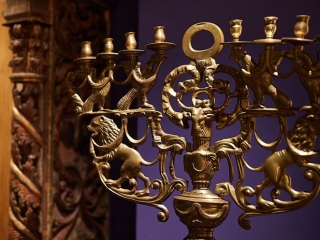Judaica in the collection of the National Museum in Krakow
Since 20th July, 2018 you can visit the renewed and expanded exhibition of Judaica from the MNK collection.
The exhibition at the Gallery of Decorative Arts in the Main Building of the National Museum in Krakow features religious ceremonial objects as well as objects used at home during holidays and on everyday basis, made of a variety of materials and with different techniques from the 17th to the 20th century. A great number of them are unique, not only on a Polish scale. What deserves special attention is a Torah Ark, carved in wood and polychromed, from a synagogue in Wysokie Litewskie, a silver alms box of a burial society, made by the goldsmith Elimelech (1763/1764), and decorated with engraved scenes of the successive stages of burial, and a wooden Hanukkah lamp from Przeworsk. On display are also numismatic objects, prints and seal stamps. The objects on exhibition, today no longer used for their original purposes and separated from their original places, can be regarded as silent witnesses to the culture of Ashkenazi Jews in Central-Eastern Europe.
The history of the Judaica collection at the National Museum in Krakow goes back to 1887, when Leonard Lepszy gifted the first silver spice container. With the passing of time the collection was growing through donations and purchases, in particular in 1935–1939, which was possible thanks to a subsidy for the purchase of Jewish handicrafts granted to the Museum by the Ministry of Religious Denominations and Public Enlightenment. As a result a collection of objects pertaining to Jewish history and culture, one of the most remarkable in Poland, was amassed. The known provenance of most of the artefacts makes it special among other similar holdings.
The history of the Judaica collection at the National Museum in Krakow goes back to 1887, when Leonard Lepszy gifted the first silver spice container. With the passing of time the collection was growing through donations and purchases, in particular in 1935–1939, which was possible thanks to a subsidy for the purchase of Jewish handicrafts granted to the Museum by the Ministry of Religious Denominations and Public Enlightenment. As a result a collection of objects pertaining to Jewish history and culture, one of the most remarkable in Poland, was amassed. The known provenance of most of the artefacts makes it special among other similar holdings.
